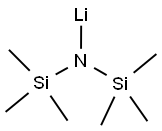Chemical Properties
light yellow to yellow crystalline powder
Physical properties
distillable low-melting solid; mp 70–72 °C, bp
115 °C/1mmHg. LHMDS is a cyclic trimer in the solid state,3
whereas in benzene solution it exists in a monomer–dimer
equilibrium. LHMDS exists as a tetramer-dimer mixture in
hydrocarbons and as a dimer-monomer mixture in THF and
ether. Treatment of LHMDS with trialkylamines increases the
monomer concentration, whereas the use of diamines affords
exclusively the corresponding chelated monomer. LHMDS
is less soluble, less basic, more stable, and much less sensitive
to air compared to lithium diisopropylamide. pKa 29.5 (THF,
27 °C).
Uses
Lithium Hexamethyldisilazide is widely used as strong nonnucleophilic base
Uses
Lithium bis(trimethylsilyl)amide is a base used in preparation of dienes and enolates. It is used to catalyze the addition of phosphine P-H bonds to carbodiimides leading to phosphaguanidines. Lithium bis(trimethylsilyl)amide is also used in a novel three-step synthesis of disubstituted 1,2,5-thiadiazoles.
Uses
Lithium bis(trimethylsilyl)amide is used as nonnucleophilic base to generate kinetic ketone and ester enolates. It is considerably more selective than LDA and undesired reductions (e.g., of nonenolizable ketones observed in the case of LDA) can be avoided by using LHMDS.
Preparation
It is conveniently prepared by the reaction of
hexamethyldisilazane with n-butyllithium in hexane. For most
uses the hexane is then evaporated and replaced with THF.
General Description
This product, 0.5 M in 2-methyltetrahydrofuran aligns with Safer Solvents and Auxiliaries, Use of Renewable Feedstocks and Inherently Safer Chemistry for Accident Prevention.
Flammability and Explosibility
Highly flammable


